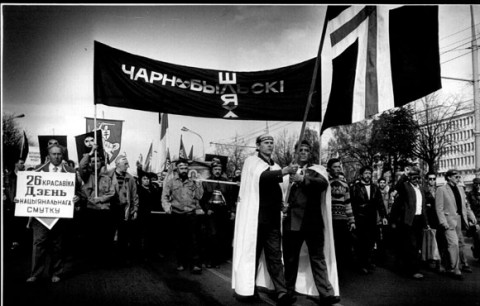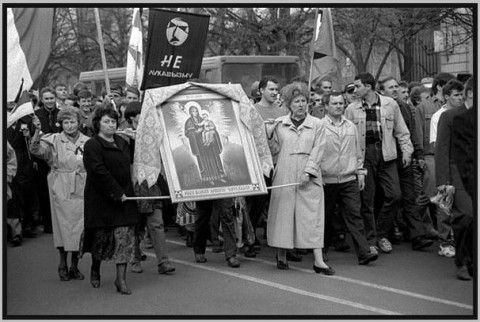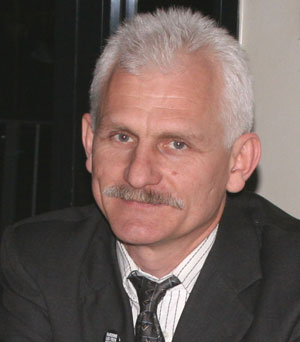Human Rights Center Viasna marsk 15th anniversary
The Human Rights Center Viasna turns fifteen
years at the time of the ongoing political lynching of the regime's opponents.
Human rights activists cannot think about celebration in such a situation.
However, it is possible to lock back at what have been done and set the goals
for the near future. This is done by Ales Bialiatski, Chair and founder of the
Human Rights Center Viasna.
The history of the Human Rights Center Viasna started from dramatic
events of spring 1996. The situation was active and tense: the Belarusian
society resisted to the large-scale violations of the Constitution and
restriction of civil and political liberties which the young at that time
president started allowing more and more frequently. Lukashenka began to
actively tighten the screws in order to completely subdue all branches of the
state power and change the Constitution according to his own needs. At first
his decisive steps were connected with dispersal of peaceful demonstrations.
The traditional Chernobyl Way
demonstration held on 26 April 1996 was the first case. Before this there
was the demonstration of 25 March, marking the anniversary of the Belarusian
People's Republic, then – a demonstration of protest against the union treaty
with Russia,
held on 2 April and attended by an unexpectedly large number of people.
However, even more people came to the Chernobyl
Way, about 40,000. The whole Yakub Kolas Square, the
place of the gathering, was densely filled with people.
The action was decorated quite well thanks to efforts of publicly active
artists from the artistic society Pahonia, there were many flags, gonfalons
and posters. The demonstrators faced problems when they started coming out to
the avenue in order to move to Peramoha
Square. The way was overlapped by several rows of
police with truncheons, and also by trucks and cars. A very violent clash with
the demonstrators took place. I want to remind that there hadn't been such
things in Belarus
since October 1988 when the police dispersed a demonstration near the
Maskouskiya cemetery dedicated to Hallowmas. Since then the authorities hadn't
dispersed any mass actions. Then, in seven years there was a violent clash,
tens of people were beaten. It happened before my eyes. I remember how artist
Ales Marachkin, who was carrying the icon of Our Lady of Chernobyl, was hit in
the eye and narrowly saved his sight. Other demonstrators were hit with
truncheons, their heads were smashed, some of them received other traumas. However, there were so many people that the police were
unable to stop the flow and the people simply pushed the cordons aside and went
forward along the square. Chernobyl
Way went to Niamiha and further, to the
Palace of Sports. Clashes took place on Niamiha Street as
well.
 About a hundred demonstrators were detained after the action. Yury Khadyka and
Viachaslau Siwchyk were arrested immediately. I was also summonsed to the
procuracy as a witness. There was a certain shock in the society, because
nothing of the kind had happened for many years. That's why there emergent an
urgent need to gather information about the places of the imprisonment and
render aid to the arrested, first of all to the families of Khadyka and Siwchyk
who went on a hunger-strike of protest under arrest.
About a hundred demonstrators were detained after the action. Yury Khadyka and
Viachaslau Siwchyk were arrested immediately. I was also summonsed to the
procuracy as a witness. There was a certain shock in the society, because
nothing of the kind had happened for many years. That's why there emergent an
urgent need to gather information about the places of the imprisonment and
render aid to the arrested, first of all to the families of Khadyka and Siwchyk
who went on a hunger-strike of protest under arrest.
A group of support to victims of political repressions was established at that
time by activists of the Belarusian Popular Front and was headed by me, the
secretary of the BPF Council at that time. It was a natural decision for me, as
problems connected with the protection of human rights have been always present
in my life. I was one of the founders of the first Belarusian human rights
organizations, The Martyrologue of Belarus, and then, being a deputy of
the Minsk City Council, was a member of the city commission for the
rehabilitation of the people who had been repressed in 1930-1950-ies.
At that time it seemed to me that our work on support to the new wave of
repressed would be temporary. If somebody had told me that we would work for 15
years and the socio-political situation would considerably deteriorate in all
respects including the legislation, the pressurization of the population and
the relation of the authorities to the civil society – I would have never
believed in it.
Having worked as the director of Maksim
Bahdanovich Liteary
Museum by that time, I
actually became a professional museum worker who saw his future life in the
Belarusian culture and literature and not just in the socio-political sphere,
as it happened to be later.
Nevertheless, the Belarusian society was put before a challenge, which
manifested in the purposeful and consequent persecution of civil society
activists first of all. The challenge was accepted. We started raising funds
for support to victims. One of my good acquaintances supplied two or three
hundred kilos of foodstuffs (macaroni, sugar, buckwheat and oil). We took it
all to the museum by a minibus. There we spread it all into bags with the
museum emblem and passed them to those who were beaten or arrested. To put it
short, we helped with what we could. We passed much food to the families of
Khadyka and Siwchyk. This was the beginning of our Viasna, a symbolic
beginning, as we can see now.
 At present, at the 25th anniversary of the Chernobyl
tragedy, it was stated once again that not only physical Chernobyl,
affecting our health, but also spiritual Chernobyl,
related to the spiritual health of Belarusian, has continued in Belarus all
these years. We got clear manifestations of this spiritual Chernobyl from the new Belarusian
authorities, which became hardened having a drudge against the young democratic
sprouts that emerged on the Belarusian land. We continued our work on the
voluntary basis, mainly in the after-work hours. Soon there started new
criminal cases, for instance against poet Slavamir Adamovich, and we rendered
material aid to his family while he was kept in the pre-trial prison.
At present, at the 25th anniversary of the Chernobyl
tragedy, it was stated once again that not only physical Chernobyl,
affecting our health, but also spiritual Chernobyl,
related to the spiritual health of Belarusian, has continued in Belarus all
these years. We got clear manifestations of this spiritual Chernobyl from the new Belarusian
authorities, which became hardened having a drudge against the young democratic
sprouts that emerged on the Belarusian land. We continued our work on the
voluntary basis, mainly in the after-work hours. Soon there started new
criminal cases, for instance against poet Slavamir Adamovich, and we rendered
material aid to his family while he was kept in the pre-trial prison.
Support to victims of political repressions became one of our main tasks which
we have been dealing with since those times. I can remember some of the first
members of our group, for instance Halina Vashchanka, Maya Kliashtornaya
(daughter of the Belarusian poet Todar Kliashtorny, who was repressed as well
as she), I and several people from our museum staff who helped us too.
Besides the material support we also gathered information about the repressed.
I should remind that after these events there was published the book Minsk
Spring-96 which described the events of the Chernobyl Way 1996 and repressions
towards its participants and contained a list of victims. We had to receive
information from different sources, for instance from the Svaboda newspaper
which often published such news, and also from participants of the actions,
whom we questioned about the events. We started maintaining a chronicle of
human rights violations almost from the very beginning of our activity and
still continue doing it now in different variants. It is an important direction
of our work, too.
The work we have been doing for these 15 years is hard and complex. It takes
much nervous energy. Constant dealing with the problems people face in the
struggle for their rights is not easy. Nevertheless, I get a great moral
satisfaction from what has been done for these years within the frames of our
organization, what has been done by Viasna within the frames of the
Belarusian and international human rights movement. Our work has been
distinguished with several authoritative international awards. There is
satisfaction from what has been done and a great dissatisfaction with the fact
that the main aim of the creation of our organization hasn't been achieved –
human rights continue to be violated in Belarus on a mass scale, the
country hasn't joined the family of civilized countries. This aims, which is to
see Belarus
a free, democratic and constitutional state, where human rights would enjoy a
real respect, makes us move forward. We will continue working in this direction
until this aim is reached.




















